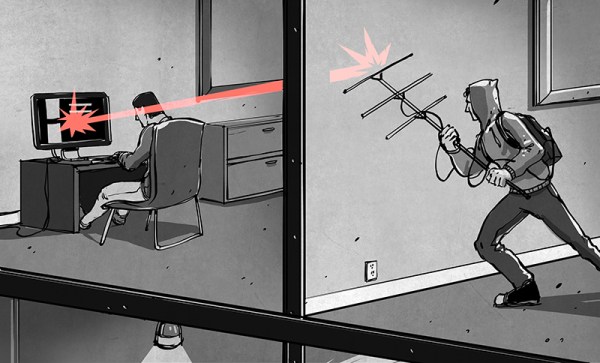The past few days have been busy if you’re trying to keep up with the pace of computer security news. Between a serious Chromium bug that’s actively being exploited on Windows 7 systems, the NSA releasing one of their tools as an open source project, and a new Spectre-like speculative execution flaw in Intel processors, there’s a lot to digest.
Continue reading “Spoiler, Use-After-Free, And Ghidra: This Week In Computer Security”
nsa20 Articles
Books You Should Read: The Cuckoo’s Egg
The mid-1980s were a time of drastic change. In the United States, the Reagan era was winding down, the Cold War was heating up, and the IBM PC was the newest of newnesses. The comparatively few wires stitching together the larger university research centers around the world pulsed with a new heartbeat — the Internet Protocol (IP) — and while the World Wide Web was still a decade or so away, The Internet was a real place for a growing number of computer-savvy explorers and adventurers, ready to set sail on the virtual sea to explore and exploit this new frontier.
In 1986, having recently lost his research grant, astronomer Clifford Stoll was made a computer system admin with the wave of a hand by the management of Lawrence Berkeley Laboratory’s physics department. Commanded to go forth and administer, Stoll dove into what appeared to be a simple task for his first day on the job: investigating a 75-cent error in the computer account time charges. Little did he know that this six-bit overcharge would take over his life for the next six months and have this self-proclaimed Berkeley hippie rubbing shoulders with the FBI, the CIA, the NSA, and the German Bundeskriminalamt, all in pursuit of the source: a nest of black-hat hackers and a tangled web of international espionage.
All Quiet On The West Virginia Border: The National Radio Quiet Zone
Ask a hundred people why they like to escape to the forest and you’ll probably get a hundred reasons, but chances are good that more than a few will say they seek the peace and quiet of the woods. And while the woods can be a raucous place between the wildlife and the human visitors, it is indeed a world apart from a busy city street, at least in the audio frequencies. But on the EM spectrum, most forests are nearly as noisy as your average cube farm, and that turns out to be a huge problem if you happen to run exquisitely sensitive radio receivers. That’s the reason for the National Radio Quiet Zone, a 13,000 square mile electromagnetic safe-zone in the woods west of Washington DC. Who’s listening to what and why are a fascinating part of this story, as are the steps that are taken to keep this area as electromagnetically quiet as possible.
Continue reading “All Quiet On The West Virginia Border: The National Radio Quiet Zone”
TEMPEST: A Tin Foil Hat For Your Electronics And Their Secrets
Electronics leak waves and if you know what you’re doing you can steal people’s data using this phenomenon. How thick is your tinfoil hat? And you sure it’s thick enough? Well, it turns out that there’s a (secret) government standard for all of this: TEMPEST. Yes, all-caps. No, it’s not an acronym. It’s a secret codename, and codenames are more fun WHEN SHOUTED OUT LOUD!
The TEMPEST idea in a nutshell is that electronic devices leak electromagnetic waves when they do things like switch bits from ones to zeros or move electron beams around to make images on CRT screens. If an adversary can remotely listen in to these unintentional broadcasts, they can potentially figure out what’s going on inside your computer. Read on and find out about the history of TEMPEST, modern research, and finally how you can try it out yourself at home!
Continue reading “TEMPEST: A Tin Foil Hat For Your Electronics And Their Secrets”
Quantum Computing Kills Encryption
Imagine a world where the most widely-used cryptographic methods turn out to be broken: quantum computers allow encrypted Internet data transactions to become readable by anyone who happened to be listening. No more HTTPS, no more PGP. It sounds a little bit sci-fi, but that’s exactly the scenario that cryptographers interested in post-quantum crypto are working to save us from. And although the (potential) threat of quantum computing to cryptography is already well-known, this summer has seen a flurry of activity in the field, so we felt it was time for a recap.
How Bad Is It?
If you take the development of serious quantum computing power as a given, all of the encryption methods based on factoring primes or doing modular exponentials, most notably RSA, elliptic curve cryptography, and Diffie-Hellman are all in trouble. Specifically, Shor’s algorithm, when applied on a quantum computer, will render the previously difficult math problems that underlie these methods trivially easy almost irrespective of chosen key length. That covers most currently used public-key crypto and the key exchange that’s used in negotiating an SSL connection. That is (or will be) bad news as those are what’s used for nearly every important encrypted transaction that touches your daily life.
THP Semifinalist: NSA Away
Back when we started The Hackaday Prize, security, big brother, and the NSA were making headlines every day. Since that time, there has been enough bread and circuses in the news to wipe the consequences of these leaks out of the public consciousness, but work is still being done by hackers and tinkerers the world over to give you the tools to protect your data.
NSA Away is one of these tools. The first part of the project is a standalone key generator that writes the same random bits to a pair of SD cards simultaneously. With their random number generator, this is perfect encryption. The only way to crack the one time pad the team is using for encryption is to 1) use parts of the pad more than once, 2) have a terrible RNG, or 3) do something really stupid like sell the one time pad in a store.
The other part of the build is an Android-based encryption device with a camera, keyboard, SD card reader, and a USB port. This device reads the ‘OTP SD cards’ and reads data with the camera using OCR and decrypts it on the screen. Provided the OTP doesn’t fall into the wrong hands, this is a perfectly secure way to transmit data to anyone.
As far as progress goes, the members of the team have a fully functional pad generator, writing random data to SD cards. This device can also output random bits to a computer as a USB HID device, should you want to transmit your pad over unsecured mediums.
It’s an impressive bit of work, especially in the RNG department. The team is using eight avalanche noise generators in the circuit description. This part of the build isn’t quite working yet, but that’s really not needed for a proof of concept.
 The project featured in this post is a quarterfinalist in The Hackaday Prize.
The project featured in this post is a quarterfinalist in The Hackaday Prize.
Using Facebook Ads To Prank Your Friends
Most tech savvy individuals are well aware of the vast amounts of data that social networking companies collect on us. Some take steps to avoid this data collection, others consider it a trade-off for using free tools to stay in touch with friends and family. Sometimes these ads can get a bit… creepy. Have you ever noticed an ad in the sidebar and thought to yourself, “I just searched for that…” It can be rather unsettling.
[Brian] was looking for ways to get back at his new roommate in retaliation of prank that was pulled at [Brian’s] expense. [Brian] is no novice to Internet marketing. One day, he realized that he could create a Facebook ad group with only one member. Playing off of his roommate’s natural paranoia, he decided to serve up some of the most eerily targeted Facebook ads ever seen.
Creating extremely targeted ads without giving away the prank is trickier than you might think. The ad can’t be targeted solely for one person. It needs to be targeted to something that seems like a legitimate niche market, albeit a strange one. [Brian’s] roommate happens to be a professional sword swallower (seriously). He also happens to ironically have a difficult time swallowing pills. naturally, [Brian] created an ad directed specifically towards that market.

The roommate thought this was a bit creepy, but mostly humorous. Slowly over the course of three weeks, [Brian] served more and more ads. Each one was more targeted than the last. He almost gave himself away at one point, but he managed to salvage the prank. Meanwhile, the roommate grew more and more paranoid. He started to think that perhaps Facebook was actually listening in on his phone calls. How else could they have received some of this information? As a happy coincidence, all of this happened at the same time as the [Edward Snowden] leaks. Not only was the roommate now concerned about Facebook’s snooping, but he also had the NSA to worry about.
Eventually, [Brian] turned himself in using another custom Facebook ad as the reveal. The jig was up and no permanent damage was done. You might be wondering how much it cost [Brian] for this elaborate prank? The total cost came to $1.70. Facebook has since changed their ad system so you can only target a minimum of 20 users. [Brian] provides an example of how you can get around the limitation, though. If you want to target a male friend, you can simply add 19 females to the group and then target only males within your group of 20 users. A pretty simple workaround
This prank brings up some interesting social questions. [Brian’s] roommate seemed to actually start believing that Facebook might be listening in on his personal calls for the purposes of better ad targeting. How many other people would believe the same thing? Is it really that far-fetched to think that these companies might move in this direction? If we found out they were already doing this type of snooping, would it really come as a shock to us?


















